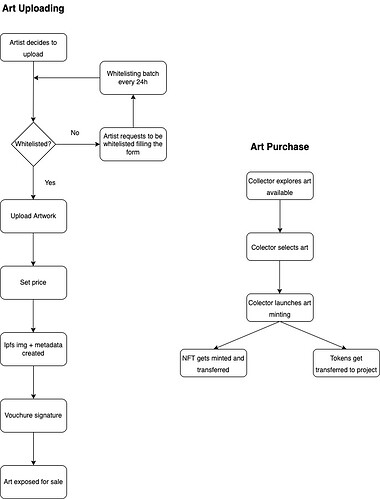Introduction
PoignART allows artists to upload art & mint NFTs. Collectors can purchase that art, but instead of the funds going to the artist, 100% of the funds go to Unchain Fund - a humanitarian aid project in Ukraine. We want to build this into Giveth as a feature for verified projects.
Artists would be able to upload art (and set the price for it) to support a verified project. Collectors can buy that art and the funds go directly to the verified projects. The GIVbacks from there will be split: 50% to the artist, 50% to the collector.
Discussion
We have been collaborating with PoignART for quite some time as they have developed a dApp for artists to donate their art for the Ukrainian cause. We like the idea of offering the same mechanic to those projects interested on implementing it so we have started conversations with PoignART group to move forward in that regard. You can take a look at their site to get the idea
After some initial discussions to understand their model and considering the differences we would have to introduce to contemplate several projects to donate instead of only one as they have, there are three main decisions we have to take and I would love to hear your thoughts.
- The blockchain to deploy our dApp.
- The smart contract formula
- The artist whitelisting
1. Which Blockchain?
The first one is the blockchain to use when deploying the dApp. PoignART has its dApp only in Mainnet, and although all governance in Giveth happens in Gnosis, we also use Mainnet with some of the pools. Using Gnosis seems to be the “natural” and cheap way to go, but most of the NFT art market happens in Mainnet and we have to think on the best option for the projects in the platform to get funds. My opinion is probably mainnet would have a bigger market to sell the art.
2. Smart Contracts
The second is the smart contract formula. As we will be dealing with art “linked” to different projects, PoignArt suggested two options. A smart contract factory, deploying one contract for every project and keeping the art collections separate, or only one contract introducing a parameter to filter the art corresponding to every project. The first option is cleaner but also more expensive in terms of deployment and maintenance. I would go for the second one.
3. To whitelist or not to whitelist?
Finally, the artist initial whitelisting request. PoignART introduced that option to avoid bots and users uploading inappropriate art. And although it introduces an extra step to the process and more maintenance cost, I do agree, we may want to keep that step so we do not experience any inappropriate art uploading.
Here’s a little flowchart showing the art uploading and selling process as PoignART have it, we should have to add an additional step to select the project the art is related to.
Resource Management
The PoignART dev team would be responsible for backend code & contracts. We would need a little support from our design team & frontend devs to make this integration happen.
Conclusion
Would love to hear your feedback, questions, ideas & concerns on this. If we decide upon the parameters, I can push this forward into creating a budgeting proposal and request funding from the GIVgarden.

 If we implement some kind of review team… I wouldn’t really want to add that on as a maintenance task for our team.
If we implement some kind of review team… I wouldn’t really want to add that on as a maintenance task for our team.